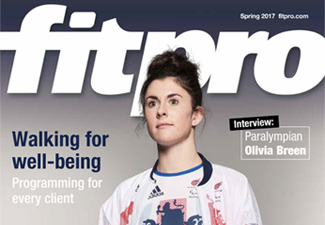Magazine References
Spring 2017

The F word
References
- oxforddictionaries.com/press/news/2016/11/17/WOTY-16, accessed 16 December 2016.
- iep.utm.edu/sophists/, accessed 16 December 2016
- bbc.co.uk/programmes/p04jqjcj, accessed 16 December 2016
- Lycholat, T. (2016) Evidence-based practice in the fitness industry, Fitpro magazine, Summer issue.
Concurrent training and the interference effect
References
- Haff, G.G. and Triplett, N.T. (2016) Essentials of strength training and conditioning, Human Kinetics, p.440.
- Leveritt, M. et al (1999) Concurrent strength and endurance training: a review, Sports Med., 28(6):413-427.
- Jackson Davis, W. et al (2008) Concurrent training enhances athletes’ cardiovascular and cardiorespiratory measures, J. Strength Cond. Res., 22(5):1503-1514.
- Fyfe, J.J. et al (2016) Endurance training does not mediate interference to maximal lower-body strength gain during short-term concurrent training, Frontiers in Physiology, doi: 10.3389/fphys.2016.00487.
- Bouchard, C. (1993) Heredity and Health-Related Fitness, Physical Activity and Fitness Research Digest, Series 1, No. 4. President’s Council on Physical Fitness and Sports.
- Davidsen, P.K. et al (2011) High responders to resistance exercise training demonstrate different regulation of skeletal muscle microRNA expression, J. Appl. Physiol., 110:309-317.
- Bamman, M.M. (2010) Does your (genetic) alphabet soup spell runner? J. Appl. Physiol., 108:1452-1453.
- Mann, T. et al (2014) High responders and low responders: factors associated with individual variation in response to standardised training, Sports Medicine, 44(8):1113-1124.
- Ericsson, K.A. (2013) Training history, deliberate practice and elite sports performance: an analysis in response to Tucker and Collins’ review – what makes champions? British Journal of Sports Medicine, 47(9):533-535.
- HL 33 (2012-13) Sport and exercise science: building on the Olympic Legacy to improve the nation’s health. London, The Stationery Office Ltd.
- Jowett, S. (2005) The coach-athlete partnership, The Psychologist, 18(7):412-415.
Intermittent fasting: what you need to know
Recommended reading
- http://jissn.biomedcentral.com/articles/10.1186/1550-2783-8-4, accessed 19 January 2017.
Bread of heaven
References
- allaboutwheat.info/history.html, accessed 23 December 2016.
- nature.com/news/2010/101018/full/news.2010.549.html, accessed 23 December 2016.
- theguardian.com/science/blog/2009/nov/26/science-breadmaking, accessed 23 December 2016.
- scienceinschool.org/2012/issue23/bread, accessed 23 December 2016.
- independent.co.uk/life-style/food-and-drink/features/the-shocking-truth-about-bread-413156.html, accessed 23 December 2016.
Client handout – need to know on H2
Reference
- who.int/nutrition/publications/guidelines/potassium_intake_printversion.pdf, accessed 17 January 2017.
Walking: the best exercise of all?
References
- I-Min Lee, et al (2012) Impact of physical inactivity on the world’s major non-communicable diseases, Lancet,, 380(9838): 219-229.
- Hanson, S. and Jones, A. (2015) Is there evidence that walking groups have health benefits? A systematic review and meta-analysis, Br J Sports Med, 0:1-7.
- Richardson, C. R. et al (2016) A comparative effectiveness trial of three walking self-monitoring strategies, Translational Journal of the ACSM, 1(15):133-142.
- walkingforhealth.org.uk, accessed 5 January 2017.
- acsm.org/docs/brochures/starting-a-walking-program.pdf, accessed 5 January 2017.
- http://journals.lww.com/acsm-msse/Fulltext/2011/07000/Quantity_and_Quality_of_Exercise_for_Developing.26.aspx
The role of exercise in cancer treatment: bridging the gap
References
- cancerresearchuk.org
- macmillan.org.uk
- Prof R, Thomas (2011), Lifestyle and Cancer: The Facts, Health Education Publications.06.
T’ai chi, falls prevention and healthy ageing
References
- Solloway, M.R. et al (2016) An evidence map of the effect of Tai Chi on health outcomes, Systematic Reviews, 5:126.
- Rimland, J.M. et al (2016) Effectiveness of non-pharmacological interventions to prevent falls in older people: a systematic overview. The SENATOR Project ONTOP series, PLoS ONE, doi: 10.1371/journal.pone.0161579.
- Stevens, J.A. et al (2014) Preventing falls with Tai Ji Quan: a public health perspective, J Sport Health Sci. 3(1):21-26.
- Tsang, W.W.N. and Hui-Chan, C.W.Y. (2003) Effects of Tai Chi on Joint Proprioception and Stability Limits in Elderly Subjects, Med. Sci. Sports Exerc. 35(12):1962-1971.
- ageuk.org.uk/professional-resources-home/services-and-practice/health-and-wellbeing/falls-prevention-resources/, accessed 3 January 2017.


